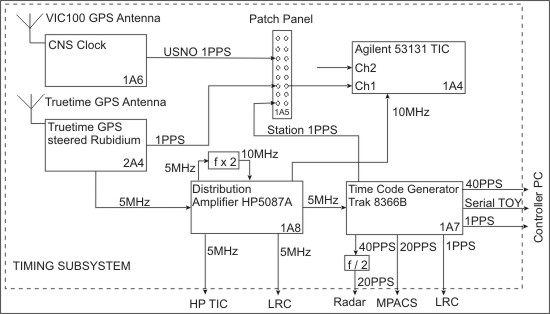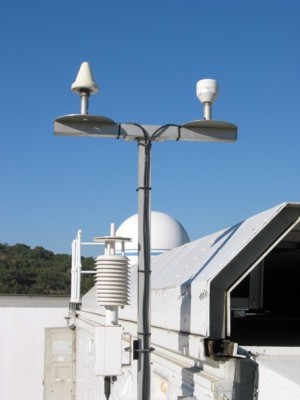
MOBLAS 6 Timing Subsystem interconnections

The Truetime GPS steered rubidium is the time standard for the SLR system, providing 1PPS to the Patch Panel and 5MHz to the Distribution Amplifier. The 1PPS is used for comparison between the time of the station and the USNO time reference, and to check the timing system delay through the Distribution Amplifier and Time Code Generator. This is checked on an Agilent 53131 TIC by connecting the relevant input on the Patch Panel to the Channel 2 input. The 5Mhz reference is passed from the GPS steered Rubidium to the distribution amplifier which provides the SLR system with the 5MHz signal and the Agilent TIC with a 10MHz signal by use of a frequency doubler. The Time Code Generator is one of the devices having 5MHz as input, from which it produces Time Code Data in the NASA 36-bit One Second format and 1, 20 and 40PPS.
The GPS antennae are mounted outside the MOMS van and steers the timekeeping of the SLR. There is a VIC100 and a Truetime antenna. They are used for both accurate timing and positioning. More information on GPS can be found here.

The CNS Clock (NSLR-03-0040) is connected to the VIC100 antenna and gives 1PPS coordinated with USNO time. It is used to determine the station offset time.

Accurate timing is provided by the Truetime GPS steered Rubidium, which provides 1PPS and 5MHz signals. More information on accurate timing can be found here.

The HP5087A Distribution Amplifier (ME-06918) amplifies the 5MHz signal for distribution to al the various subsystems. It also has a frequency doubler to supply the Agilent TIC with a 10MHz signal.

Time code is produced in the NASA 36 bit format by the Trak 8366B (ME-12771) Time Code Generator. This device also supplies various pulsed signals to other subsystems. The connections to the Controller are made through a multiplexer.

The patch panel allows for easy interconnection between various channels for measurements made by the Agilent 53131 TIC.

